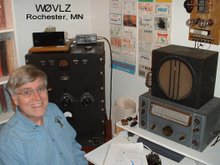Tonight I got on the air with my latest endfed wire and had good success working both New Mexico and Pennsylvania.
I've been concerned about running a non-resonant endfed 58' wire with a single counterpoise laying on the ground. It sort of felt like an off center fed windom with half of the antenna on the ground.
I put together a 20 mtr end fed zepp (14'3" of TV twin lead with the hot

side feeding 33'3' of wire) and arranged it as a sloper with the KX3/feedpoint on my deck about 8' off the ground, the twin lead/wire connection about 20' off the ground, and the far end of the antenna about

1' off the ground. Now the ground side of the antenna system is up in the air rather then laying on the ground. It seems to work pretty good on 20 and as a bonus the KXAT3 antenna tuner can also load it

up on 40, 30, 17 and 10. (Not the most efficient radiator on these "bonus" bands but if I can make contacts it is good enough). The reverse beacon system at
http://www.reversebeacon.net says I'm getting out.
Besides set up as a sloper (more or less) this antenna can be deployed as an inverted V, an inverted L or a vertical...mostly how ever is convenient to get some part of it up in the air. The 33' 3"portion of mine is Radio Shack insulated 18 gauge stranded copper wire. It runs over tree limbs just fine. Unfortunately Radio Shack no longer sells the light weight twin lead that I used...but any twin lead or ladder line will work but the 14'3"length will need to be adjusted depending on the twin lead velocity factor.
(Just an additional note....where did 33'3" and 14'3" come from?
What I have is a 20mtr EFHW with a quarter wave matching section. At 14.060 MHz a EFHW is 468/14.060 or 33.3'. Even the KX3 ATU can't match this 33'3" wire directly, it is too high of an impedance. The quarter wave matching section transforms the high impedance feedpoint of the EFHW to a lower impedance that the KX3 can handle. At 14.060MHz a quarter wave is 246/14.060 or 17'6". Assuming a velocity factor of 80% gets the length to 14'3". )
(Something else, the KXAT3/tuner is still needed, even on 20. Nothing's perfect and the twin lead quarter wave matching section can only be said to transform high impedance to low impedance. How high and how low changes with how/where this antenna is deployed. The KXAT3/tuner covers the variable.)
 This past weekend I was able to put a 1929 transmitter on the air and participate in the AWA Bruce Kelley Memorial 1929 QSO Party.
This past weekend I was able to put a 1929 transmitter on the air and participate in the AWA Bruce Kelley Memorial 1929 QSO Party. This year I used a transmitter I acquired from Vance, K5CF (SK). Vance, my step father, gave me my novice test in 1966. He enjoyed ham radio for over 70 years. Several years ago Vance encouraged me to participate in the 1929 QSO Party. Vance's transmitter is a TNT (or Tuned plate Not Tuned grid) transmitter using a single type 210 tube. With 340 volts on the plate it runs 9 watts input and about 2 watts out. Vance built his transmitter based on the one Bill Orr described one in the January 1973 issue of CQ but the original design dates from the 20s. See the December 1929 issue of QST for George Grammer's version of the same transmitter. For an antenna I used a 105' end fed inverted L only about 15' off the ground.
This year I used a transmitter I acquired from Vance, K5CF (SK). Vance, my step father, gave me my novice test in 1966. He enjoyed ham radio for over 70 years. Several years ago Vance encouraged me to participate in the 1929 QSO Party. Vance's transmitter is a TNT (or Tuned plate Not Tuned grid) transmitter using a single type 210 tube. With 340 volts on the plate it runs 9 watts input and about 2 watts out. Vance built his transmitter based on the one Bill Orr described one in the January 1973 issue of CQ but the original design dates from the 20s. See the December 1929 issue of QST for George Grammer's version of the same transmitter. For an antenna I used a 105' end fed inverted L only about 15' off the ground.





















